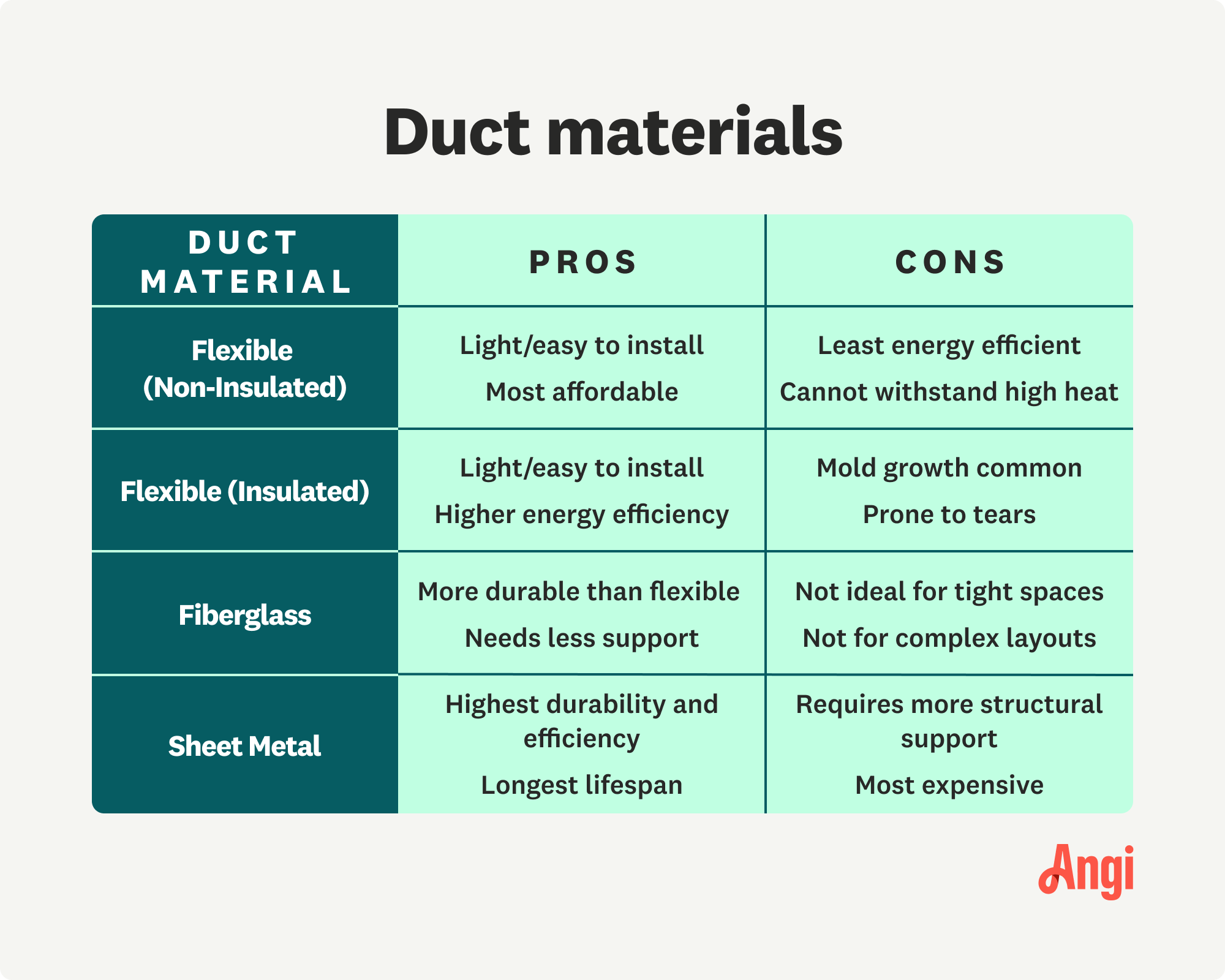How Much Does Air Duct Replacement Cost? [2025 Data]
Air duct replacement costs $453 to $2,189, with an average of $1,252. You’ll pay more for high-end materials or difficult access points.


Air duct replacement costs $1,252 on average, but prices can range between $453 to $2,189. Properly functioning air ducts are a crucial aspect of maintaining indoor air quality and energy-efficient HVAC systems. However, these ducts only last 10 to 15 years before issues with leaks, blockages, or reduced energy efficiency arise. It's helpful to understand the factors that influence air duct replacement costs before you schedule installation.
Duct Replacement Cost by Home Size
The size of your home directly affects air duct replacement costs. Larger homes require more materials and labor to replace the entire duct system. On average, the cost ranges from $2,000 to $5,000 for a small to medium-sized home. However, duct replacement can run as low as $1,400 for smaller homes and as high as $9,000 for larger homes.
| Home Size (Sq. Ft.) | Average Cost |
|---|---|
| 1,000–2,000 | $1,400–$4,500 |
| 2,000–3,000 | $2,800–$6,700 |
| 3,000–4,000 | $4,200–$9,000 |
Cost by Location of Ducts
If only specific sections of your ductwork need replacement, such as in a renovation project, costs can vary based on the location of the damaged or worn ductwork. Replacing ducts in hard-to-reach or concealed areas—like attics, basements, ceilings, walls, or crawl spaces—might increase labor costs.
| Location | Average Cost |
|---|---|
| Exposed | $700–$3,000 |
| Wall or ceiling | $1,000–$4,000 |
| Basement | $1,800–$3,100 |
| Attic | $2,200–$5,600 |
| Crawl space | $3,000–$7,300 |
Cost by Duct Material

The material you choose for your replacement ducts affects both their cost and longevity. Sheet metal ducts, for example, are durable but pricier. Flexible ducts, on the other hand, are more affordable but may need to be repaired or replaced sooner.
| Duct Material | Average Cost per Linear Foot |
|---|---|
| Flexibile (non-insulated) | $1–$3 |
| Flexible (insulated) | $2–$4 |
| Fiberglass | $4–$6 |
| Sheet metal | $7–$13 |
Cost to Hire an HVAC Pro to Replace Ductwork
HVAC professionals charge between $50 and $110 per hour. Air duct replacement typically takes between five and seven hours. You can expect to pay around 40% in material costs and the other 60% in labor. For example, an air duct replacement with a total project cost of $4,800 will amount to around $2,880 in labor and $1,920 in materials and parts.
The price of an HVAC professional rises significantly though if there are serious complications like mold growth or damage that requires additional work. Certain HVAC professionals may not work in specific places—like a crawl space—and you may need to pay a premium for ductwork with difficult access.
Additional Air Duct Replacement Cost Factors

Depending on the state of your current ductwork and required permits, you may need to budget for some of the additional costs outlined below.
Insulation Needs
Insulation is complicated because there is no one-size-fits-all approach. A crawl space in Alaska will require significantly more—and thicker—insulation than the same ductwork in Indiana. Different duct materials carry their own insulating properties as well, which affects the amount of additional insulation required. For example, sheet metal ductwork is much more efficient than flexible ducts. This means it may require less insulation, but may have other drawbacks.
On average, air duct insulation costs between $800 and $2,000 when materials and labor are factored in. Insulation can cost $1 to $8 per square foot, but the cost can vary depending on the insulation material, accessibility of the duct, and the home’s size.
Some of the most common insulation materials and their costs are:
Flexible fiberglass: $1 to $4 per sq. ft.
Flexible mineral wool: $2 to $4 per sq. ft.
Rigid or foam board fiberglass: $4 to $8 per sq. ft.
Addressing Asbestos or Mold
Before replacement, an inspection might reveal asbestos or mold. Dealing with these issues safely adds to the overall cost but is essential for a healthy living environment. Checking for and dealing with these harmful substances can range from $250 to $6,000 overall.
Some individual costs associated with addressing asbestos or mold include:
Asbestos inspection and testing costs $250 to $700
Mold inspection and testing costs $200 to $650
Asbestos removal costs $700 to $2,200
Mold remediation costs $450 to $6,000
Drywall Repair
Duct replacement may require opening up walls or ceilings in order to access the air duct. Be sure to budget for potential repair and repainting costs to restore the aesthetics of your living spaces. On average, drywall repair costs can range from $150 to $325, while ceiling repairs can be $300 to $1,200.
Required Permits
Some local regulations may require permits for major home improvements, including air duct replacement. Check with local authorities to factor in any permit fees, but if permits are required, the cost for one that will allow for replacement air ducts on an existing HVAC system could be between $250 and $1,500.
Adding Vents
Enhancing ventilation through additional vents improves air circulation, and each added vent costs roughly $250 to $500, depending on the home layout. Budget for the cost of new vents and the labor to install them effectively, but also keep in mind that this addition may increase your energy bills since adding additional HVAC air vents lowers the overall system efficiency.
DIY vs. Hiring a Pro to Replace Ductwork
For experienced DIY enthusiasts, replacing air ducts may seem like a cost-saving option. However, it’s generally not advisable (or legal) to complete a DIY air duct replacement, as it’s a complex task that requires precise measurements, cutting, and sealing. Be aware that improper installation could lead to:
Air leaks
Poor energy efficiency
Damaged HVAC systems
Failed home inspections
Issues with homeowners insurance
Invalidation of HVAC system warranties
For these reasons, we urge you to employ the services of local air duct installers to ensure the duct replacement job is completed efficiently, properly, and in line with local ordinances and warranties you may hold.
Repairing vs. Replacing Ductwork

Depending on the issue, it can be much more cost-efficient to repair ductwork than replace it. A few leaks in a specific section of ductwork is not an expensive fix compared to swapping the entire system. However, if the entire length of air duct is leaking, you’ll need to swap it out for new material. For minor issues, you can save 90% of the cost of replacing ductwork by addressing the individual issue.
There are some cases where replacing all the existing ductwork may be less expensive overall. If a section of ductwork is degrading from age, the rest of the ductwork is likely undergoing a similar change. In that case, it’ll cost less to swap it all at once versus replacing each section individually over time. Significant mold or other biological issues also require replacing the entire system.
How to Save Money When Replacing Air Ducts
By now, you can see that this isn’t the most budget-friendly project. Here are a few easy ways to save money or get the most out of what you pay:
Compare quotes: Obtain multiple quotes from reputable local contractors to find the best deal.
Energy-efficient options: Opt for insulated ducts to reduce long-term energy costs.
Bundle services: If addressing multiple home improvements, bundle them for potential discounts.
Regular maintenance: Maintain your ducts to extend their lifespan and prevent costly replacements.
Seal leaks promptly: Do a simple DIY duct leakage test and address leaks promptly to prevent energy loss and further damage.
How Angi Gets Its Cost Data
Home is the most important place on earth, which is why Angi has helped more than 150 million homeowners transform their houses into homes they adore. To help homeowners with their next project, Angi provides readers with the most accurate cost data and upholds strict editorial standards. We’ve surveyed thousands of real Angi customers about their project costs to develop the pricing data you see, so you can make the best decisions for you and your home. We pair this data with research from reputable sources, including the U.S. Bureau of Labor Statistics, academic journals, market studies, and interviews with industry experts—all to ensure our prices reflect real-world projects.
Want to help us improve our cost data? Send us a recent project quote to costquotes@angi.com. Quotes and personal information will not be shared publicly.
Frequently Asked Questions
You have the option to replace only a portion of your ductwork. This approach can be particularly cost-effective, especially if you're undergoing renovations or addressing specific issues in your home's ventilation system.
Replacing a section of your ductwork instead of the entire system is a strategic choice that allows you to target areas that need improvement without unnecessary expenses. For instance, if you're remodeling a specific part of your house or noticing problems in certain ducts, partial replacement can be a perfect solution.
If your ducts are relatively free from significant damage, mold, or excessive debris, the benefit of air duct cleaning is that it can address many common issues. Dust, allergens, and particles can accumulate in your ducts, affecting air quality and the efficiency of your HVAC system. Cleaning your ducts can help you restore optimal airflow and remove pollutants that might be circulating in your home.
However, cleaning might not be the best solution if your ducts have severe damage, leaks, or are significantly outdated. In these cases, replacement might be necessary to ensure proper functioning and prevent future problems.
Opting for insulated ducts can lead to significant long-term savings on your energy bills and contribute to a more efficient HVAC system. The precise amount you can save depends on various factors, including your climate, usage patterns, and the insulation's quality. However, on average, insulated ducts can result in savings of up to 20% on your annual heating and cooling costs, according to ENERGY STAR®.





- Furnace Repair
- Air Conditioning Repair
- HVAC Repairs
- Furnace Installation
- Wood & Pellet Stove Repair
- Dehumidifier & Humidifier Repair
- Heat Pump Companies
- Swamp Cooler Repair
- Wood Stove Services
- HVAC Companies
- Commercial A/C Repair
- Geothermal Installation
- Air Conditioning Installation
- Boiler Repair
- 24 Hour Furnace Repair
- Geothermal Repair
- Heat Pump Repair
- Humidifier Installation
- Thermostat Repair
- Thermostat Installation
- Nest Installation
- Heating & Cooling
- Heating Repair
- Furnace Cleaning
- Furnace Tune-Up
- HVAC Technicians
- Subcontractors
- Furnace Maintenance
- Plumbing & Heating Companies
- Wood Stove Inspection
- Mini Split Installation
- Wall Heater Repair
- Duct Installers










